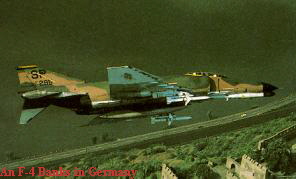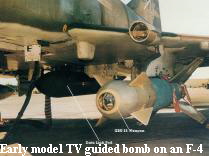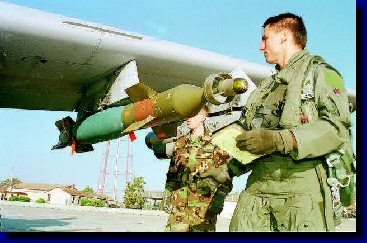|
"We used
to say we were dropping a Cadillac," -- retired U.S. Air Force Lieutenant
Colonel Dean Failor.
The basic
operational concept for laser guidance and targeting from a combat aircraft was
simple. The Weapons System Operator would use a laser marking device mounted
on the back-seat canopy of one F-4 to illuminate that target. Another F-4
loaded with the laser guided bombs would make the attack dive bomb run.
Depending on fuel loads, the Phantom could carry two 2,000 pound guided bombs.
The number was fewer because the fixed guidance fins on the bomb only allowed
one bomb per station on the fighter. In later versions of the Paveway bomb,
folding rear fins allowed for two bombs to be loaded on aircraft bomb station
hardpoints.
Later in the
Vietnam  War fighters used pods and could designate their own targets
or a target for a flight of F-4s, but even the buddy system, which put two
aircraft at risk instead of one, was deemed so accurate by the Air Force it went
into combat trials and was later dubbed the Pave Light system (PAVE is an
acronym for Precision Avionics Vectoring Equipment) when the back-seat
illumination routine was used in combat. Later, Pave Knife pods, the primitive
precursor to current day targeting pods, were carried by a single F-4 in a two
or four ship flight. The pods allowed one aircrew to illuminate a target and
several to drop their guided bombs on it. War fighters used pods and could designate their own targets
or a target for a flight of F-4s, but even the buddy system, which put two
aircraft at risk instead of one, was deemed so accurate by the Air Force it went
into combat trials and was later dubbed the Pave Light system (PAVE is an
acronym for Precision Avionics Vectoring Equipment) when the back-seat
illumination routine was used in combat. Later, Pave Knife pods, the primitive
precursor to current day targeting pods, were carried by a single F-4 in a two
or four ship flight. The pods allowed one aircrew to illuminate a target and
several to drop their guided bombs on it.
This was a particularly useful
tactic for well protected, sturdy bridges. By summer 1973, just before
airstrike operations from bases in Thailand were canceled, F-4s were equipped
with the more advanced Pave Spike pod which featured a television-laser
combination tracking and targeting system, a bomb release computer and an easy
access cockpit mounted control panel. The pod, which resembled a long tube with
a big bulging bulb on the forward end, was mounted on one of the Phantom's
centerline Sparrow missile wells. This freed up a wing station for more
ordnance.
After initial test practice runs for aircrews, the bombs were
easy to use, unlike the complicated optical glide bombs and missiles of th e day. More importantly to the Air Force, the bombs not only
came within the thirty foot target designation, they were cheap. When compared
to other "precision" guided weapons at the time, Paveway I was a frugal
investment. The GBU-8 television guided bombs which had a higher failure rate,
cost the government around $17,000, but the initial Paveway bombs were priced at
around $4,000, Word remembers, and as the production lines geared up near the
end of the Vietnam War the bomb prices had dropped to $2,000 a copy. e day. More importantly to the Air Force, the bombs not only
came within the thirty foot target designation, they were cheap. When compared
to other "precision" guided weapons at the time, Paveway I was a frugal
investment. The GBU-8 television guided bombs which had a higher failure rate,
cost the government around $17,000, but the initial Paveway bombs were priced at
around $4,000, Word remembers, and as the production lines geared up near the
end of the Vietnam War the bomb prices had dropped to $2,000 a copy.
Compared to the pay stub of a young Air Force officer of the time, though, the
bombs were deemed expensive, but the aircrews wouldn't have traded them for the
bomb's weight in gold in combat. "We used to say we were dropping a Cadillac,"
retired U.S. Air Force Lieutenant Colonel Dean Failor recalled. "They were very
accurate, and I guess compared to other munitions of the time cheap, but to us
'Crew Dogs' they were Cadillacs. They were worth a Cadillac too, because they
worked. We really didn't like the electo-optical guided bombs because they
didn't always work." Failor was a WSO who used laser guided bombs from
1970-1973 in tours of duty in Southeast Asia including the Linebacker I and II
campaigns.
The bombs were used for more that just dropping bridges, Failor
said. "They were very versatile. We used them for cutting road junctions along
the (Ho Chi Mihn) Trail, hitting bulldozers, just  about all hardened targets and even destroying tanks," Failor
recalled. "I remember one bulldozer we hit that had been hidden in a bomb crater
at a difficult angle (to strike). We put the laser guided bomb right on it, and
the dozer just started tumbling end over end." about all hardened targets and even destroying tanks," Failor
recalled. "I remember one bulldozer we hit that had been hidden in a bomb crater
at a difficult angle (to strike). We put the laser guided bomb right on it, and
the dozer just started tumbling end over end."
Within Texas Instruments
there was a lot of hoopla surrounding Paveway bombing accuracy, Tom Weaver
thought. "A lot of people say those bombs were coming within seven to ten feet
of the target. I don't think we ever got them that close, but we sure got them
within the 30-foot range," Weaver said.
Although very accurate, Paveway
bombs were not magic bullets. Launch parameters, which pilots call a "basket,"
had to be followed or the bombs would not guide. The release parameters were
much the same as dive bombing -- roll in on the target around 20,000 feet,
acquire the target and release the bomb at about 10,000 feet. The laser guidance
allowed the pilots to pull out the desired 10,000 foot altitude mark, largely
above the bulk of the deadly ground fire. "You had to be good at what you were
doing," Failor said. "There's no doubt about that. There had to be cooperation
between the guy in back and the pilot and a general understanding of how the
bomb worked. Once you got that down, though, it went well. When you used it
properly the laser guided bomb was so much better than a regular iron bomb that
there is just no comparison."
Drawbacks to the weapons usage were cloudy
weather, and also haze and smoke from previous bomb runs could pose a problem.
The first Paveway systems had no night time capability. Even with the
drawbacks, though, the bombs racked up a 68-percent kill record. By the end of
the conflict in Vietnam, the Air Force had used more that 25,000 laser guided
bomb units, and 17,000 had been judged successful.
Continue to "End Result"
|
|














 War fighters used pods and could designate their own targets
or a target for a flight of F-4s, but even the buddy system, which put two
aircraft at risk instead of one, was deemed so accurate by the Air Force it went
into combat trials and was later dubbed the Pave Light system (PAVE is an
acronym for Precision Avionics Vectoring Equipment) when the back-seat
illumination routine was used in combat. Later, Pave Knife pods, the primitive
precursor to current day targeting pods, were carried by a single F-4 in a two
or four ship flight. The pods allowed one aircrew to illuminate a target and
several to drop their guided bombs on it.
War fighters used pods and could designate their own targets
or a target for a flight of F-4s, but even the buddy system, which put two
aircraft at risk instead of one, was deemed so accurate by the Air Force it went
into combat trials and was later dubbed the Pave Light system (PAVE is an
acronym for Precision Avionics Vectoring Equipment) when the back-seat
illumination routine was used in combat. Later, Pave Knife pods, the primitive
precursor to current day targeting pods, were carried by a single F-4 in a two
or four ship flight. The pods allowed one aircrew to illuminate a target and
several to drop their guided bombs on it.  e day. More importantly to the Air Force, the bombs not only
came within the thirty foot target designation, they were cheap. When compared
to other "precision" guided weapons at the time, Paveway I was a frugal
investment. The GBU-8 television guided bombs which had a higher failure rate,
cost the government around $17,000, but the initial Paveway bombs were priced at
around $4,000, Word remembers, and as the production lines geared up near the
end of the Vietnam War the bomb prices had dropped to $2,000 a copy.
e day. More importantly to the Air Force, the bombs not only
came within the thirty foot target designation, they were cheap. When compared
to other "precision" guided weapons at the time, Paveway I was a frugal
investment. The GBU-8 television guided bombs which had a higher failure rate,
cost the government around $17,000, but the initial Paveway bombs were priced at
around $4,000, Word remembers, and as the production lines geared up near the
end of the Vietnam War the bomb prices had dropped to $2,000 a copy. about all hardened targets and even destroying tanks," Failor
recalled. "I remember one bulldozer we hit that had been hidden in a bomb crater
at a difficult angle (to strike). We put the laser guided bomb right on it, and
the dozer just started tumbling end over end."
about all hardened targets and even destroying tanks," Failor
recalled. "I remember one bulldozer we hit that had been hidden in a bomb crater
at a difficult angle (to strike). We put the laser guided bomb right on it, and
the dozer just started tumbling end over end."